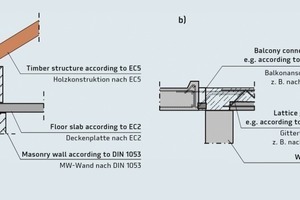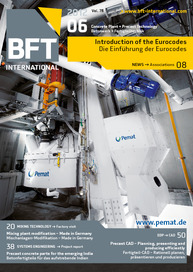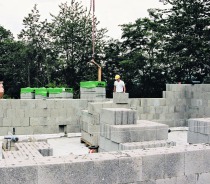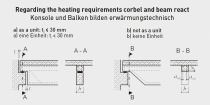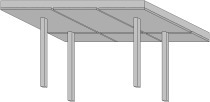Introduction of the Eurocodes in Germany
“Europe can be likened to two elephants making love: it stirs up a lot of dust and takes a long time until results are achieved.“ (Willy Brandt, 1913-1992, German politician)
This year, the introduction of the structural engineering Eurocodes in Germany marks another step on a long path that began more than 50 years ago, with the ultimate objective of establishing the free movement of goods in Europe. On 25 March 1957, the then European Council signed the Treaty of Rome and adopted “actions which have as their object the establishment and functioning of the internal market“ (Article 95 of the Treaty of Rome). Another milestone on this route was the White Book published by the European Commission that preceded the Single European Act of 1985. It listed almost 300 measures that were considered necessary for establishing a European single market and gave rise to an identical number of directives.
As part of this endeavor, the 1989 Construction Products Directive [1] was to ensure the free movement of goods within the European Union in the field of construction products. This objective was to be achieved by establishing a common technical vocabulary set forth in European product standards and approvals, which, in turn, required European design codes in order to rely on a common basis. In this context, the Eurocodes cover the area of structural engineering.
As early as in the 1980s, the predecessors of today‘s Eurocodes had been prepared by international groups of experts on behalf of the European Commission without the European legal framework referred to above. On the basis of the Model Code [2] drafted by the international federations CEB and FIP (which were merged in 1998 to form the international precast concrete federation, fib), a first Eurocode 2 draft was prepared, which became part of the system of German standards at the end of 1991 as the preliminary standard ENV
1992-1-1 and was subsequently integrated as DIN V ENV 1992-1-1 by the German Institute for Standardization in the middle of 1992. Overall, the ENV 1992 series included nine parts [3].
Since these were only preliminary standards, no withdrawal of national standards was required, which resulted in the option of applying the Eurocodes as an alternative to DIN 1045 [4]. A survey conducted among the CEN member states in 1994 showed that the pre-standards needed to be transferred to final, binding standards. The European Commission issued a mandate for the associated revision activities [5]; this mandate defined the underlying framework (see also [6]).
Following a phase of fundamental revision (such as reducing the number of Eurocode 2 parts), publication of the second generation of Eurocodes started in 2002. Further editorial changes and several corrections led to the publication of the 2010/11 German versions of the Eurocodes by DIN, which are now in the process of being officially introduced.
The „nationally adjusted“ Eurocode
In 1996, the German Committee for Structural Concrete (DAfStb) decided to prepare a national design standard (DIN 1045-1) that was to come very close to the European set of standards because the German design standards applicable in the mid-1990s, DIN 1045 [4] and DIN 4227 [7], did no longer represent the state of the art according to experts whilst the amount of work to be done at the European level was very hard to estimate. The prevailing opinion was that “the transition effort required in the event of a later introduction of the European standards would be minor, if at all existent, due to the close linkage to the concept of European standards (...)“ [8].
Since the European design concept was introduced already by this “intermediate national step” of implementing DIN-1045-1 [9], German experts have been applying the „nationally adjusted“ Eurocode at least since 2005. For this reason, the transition effort to be made this year will indeed be minor from a technical point of view, as predicted by the DAfStb 16 years ago. However, this process will require additional efforts, such as
familiarization with the formal and editorial characteristics of the Eurocodes,
purchase of new literature and design software,
an increased amount of further training.
Eurocodes and product standards
The Construction Products Directive [1] (which has recently been replaced with [10]) contains basic requirements for construction products and structures, which include structural integrity, fire resistance and safety in use. The European product standards governing precast elements make reference to Eurocode 2 to comply with the basic requirements No. 1, „Structural Integrity“, and No. 2, „Fire Safety“. Fig. 1 lists other important reference standards. This representation reveals significant differences between the European and the German system. DIN 1045-1 [11] was also aligned with the European set of standards because not all precast elements (such as solid floor slabs) are governed by European product standards.
In general, the question arises whether the objective of establishing the free movement of goods is at all achievable for structural precast components. These are not „traded“ in the strict sense of the word because each element is a product „tailored“ to a specific position within a structure. In addition, the scope of movement of structural precast components across Europe is limited by design because of the high amount of transport and the associated cost.
On the other hand, Central European countries have always benefited most from the European idea and its practical implementation. Countries such as Germany are in a particularly good position that opens up huge opportunities in the construction sector. It remains to be seen whether these opportunities will actually be seized.
Eurocodes and their National Annexes
The ten Eurocodes pertaining to structural engineering (EN 1990 to EN 1999) comprise a total of 58 parts, which deal with all aspects of the individual fields
(Fig. 2). Eurocode 2 (EC2) governing the design of precast elements consists of four parts [12], [13], of which Part 2 pertaining to bridges and Part 3 governing containment structures merely contain supplementary design rules and can only be applied in conjunction with the main part, EC2 Part 1-1. Part 1-2 of EC2 covers fire safety design (Fig. 3). Each Eurocode part is complemented by a National Annex (NA), which contains the following:
figures for nationally determined parameters (NDP), such as partial safety factors,
country-specific data, such as maps showing snow or earthquake zones,
rules for the application of the informative annexes,
non-contradictory complementary information (NCI).
The so-called NCI documents provide a certain room for interpretation as to whether a complementary part is contradictory or not. For example, the German National Annex to EC2 Part 1-1 contains over 100 pages of NCI (i.e. four fifths of the document). Unfortunately, not all of this information is non-contradictory to the original Eurocode. As demonstrated when looking more closely at the situation in Austria, other countries did not succeed either in fully implementing the requirement of non-contradictory information. In Austria, a new National Annex was published in 2011 [14] that contains a range of complementary national documents and explanations that had not been included in the previous version [15].
Despite all efforts made to implement European design standards, it should be noted, on the basis of the National Annexes, that national rules and safety levels, and thus national standards, continue to exist. All parties involved should endeavor to reduce these national differences to a minimum in the future.
To facilitate application in Germany, the relevant DIN committees issue so-called manuals that contain both the Eurocode texts and the wording of the associated National Annexes. Two volumes are planned for Eurocode 2 [16]:
Vol. 1: General rules (with EC2 Parts 1-1, 1-2 and 3);
Vol. 2: Concrete bridges.
Nearer the time of the official introduction of the Eurocodes, the German Committee for Structural Concrete (DAfStb) will publish its Vol. 600 [17] as an additional design aid containing explanations and background information on Eurocode 2.
Eurocode 2 for precast elements
One of the particular features of EC2 Part 1-1 is its Section 10, which contains additional rules for precast elements. However, Sections 1 to 9 also include basic design rules for precast components (Fig. 4). Section 10.9 contains specific construction rules, such as for notched supports or bucket and block foundations. These specifications, however, do not give rise to any new conclusions (Fig. 5).
Section 4.4.1.3 (3) of the National Annex includes the general option of reducing the cover Dcdev by 5 mm if an appropriate quality control system is in place. However, Section 10 contains an additional rule for precast components, according to which the cover Dcdev may also be reduced by more than 5 mm pursuant to NA.10.4 for precast components if adherence to the minimum concrete cover is verified for the finished element. Any reduction in Dcdev below 5 mm is not permissible (see further information in [17]).
In this area, the verifications of foundations are of particular interest to precast construction. For example, compact foundations having a slenderness of l ≤ 2.0 initially require the iterative determination of the critical section acrit, which involves an additional computation step. By contrast, a critical section of acrit = 1.0 d is assumed for foundation slabs and slender foundations.
The minimum shear resistance value vmin previously used for verifying shear resistance is now also applied to punching shear resistance. This approach results in greater resistance without punching shear reinforcement in the case of thick elements with correspondingly low longitudinal reinforcement ratios and high concrete strengths. In foundations with punching shear reinforcement, the reduced effective shear force VEd,red must be taken up by the reinforcement without deducting any share to be resisted by the concrete (Fig. 6).
Deformation limit state
Limiting the span-to-depth ratio is one of the options for performing a simplified verification of deformation. For this verification, the required reinforcement ratio and the steel stresses must be known. Strictly speaking, this means that this method is only suitable for a final design verification. Parameters thus need to be estimated in advance for the purpose of predimensioning. This poses the risk that the estimate is either too conservative, and thus commercially unviable, or unsafe, which would mean that the entire structural verification would need to be repeated using more accurate parameters.
The degree of deformation tends to decrease in line with higher concrete strength classes and lower loading, which leads to an increase in the permissible span-to-depth ratios and to a reduction in the required element thicknesses (Fig. 7). The span-to-depth ratio criteria may no longer be applied to prestressed concrete components. In these cases, deformation control can only be verified by direct calculation methods.
The only rule contained in Annex A that was released for application in Germany is the option of reducing the partial safety factor for concrete to γC = 1.35 if the concrete strength is verified for the finished structural component (see further information in [17]).
Introduction of the Eurocodes
The structural engineering parts of the Eurocodes to be officially introduced were announced in the publication of the draft list of technical building regulations (Musterliste der Technischen Baubestimmungen; MLTB [18]) in December 2011. This version is scheduled for introduction in the individual countries on 1 July 2012. The official introduction of the Eurocode parts pertaining to bridge construction is scheduled for 1 December 2012.
The prohibition of combining ‚old‘ and ‚new‘ rules is abolished to continue to be able to design all types of structural frameworks without restrictions. This means that it will still be permissible to design individual structural components according to the ‚old‘ rules until all Eurocodes have been officially introduced, provided that these components form separate substructures within the overall structural framework and that a meaningful transfer of parameters from one substructure to the other is ensured (Fig. 8a).
Accordingly, when applying national technical approvals and type tests that still refer to ‚old‘ rules, the relevant structural component shall be designed according to the rules and standards referred to in the type test or approval whilst the adjoining structural framework shall be designed in accordance with the Eurocodes (Fig. 8b). DIN 4149 continues to apply to the verification of earthquake resistance until the introduction of Eurocode 8. All references to DIN 1045-1 shall be replaced with references to Eurocode 2 (see also MLTB, Annex 5.1/1).
Future of the Eurocodes
Prior to the implementation of the Eurocodes in Germany, the members of the relevant European committee (CEN/TC 250) are already working on the third generation of Eurocodes whose completion is scheduled for 2018 according to current plans. In very much the same way as 13 years ago, these activities rely on a mandate issued by the European Commission [19]. The CEN answer to the mandate [20] includes the following provisions for the „Eurocodes 2018“:
to reduce the nationally determined parameters (NDP) and non-contradictory complementary information (NCI),
to improve the clarity of the codes,
to avoid the inclusion of rules and provisions that are far removed from reality.
In addition, Eurocode 2 should be extended to include provisions on fiber-reinforced concrete and the reinforcement of structural concrete components and existing structures.
„Our entire life is an eternal new beginning.“ (Hugo von Hofmannsthal, 1874-1929, Austrian novelist)

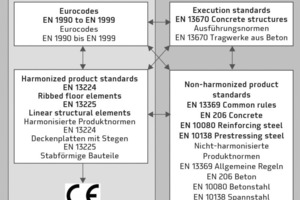
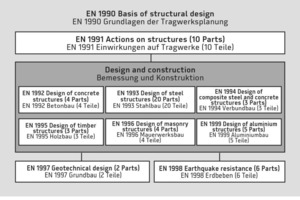
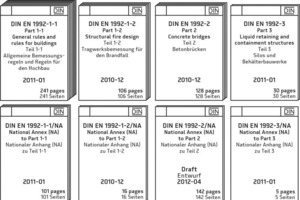
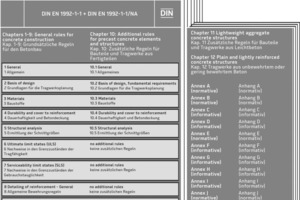
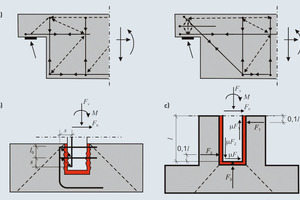

![7Required element thickness h [m] depending on the span l [m] according to DIN 1045-1 and EC2 for a floor slab a) of strength classC 30/37, b) of strength class C 50/60](https://www.bft-international.com/imgs/tok_3aab56e092cfa31c6e7e79f33be030fb/w300_h200_x400_y171_103934080_38ed53fe54.jpg)
